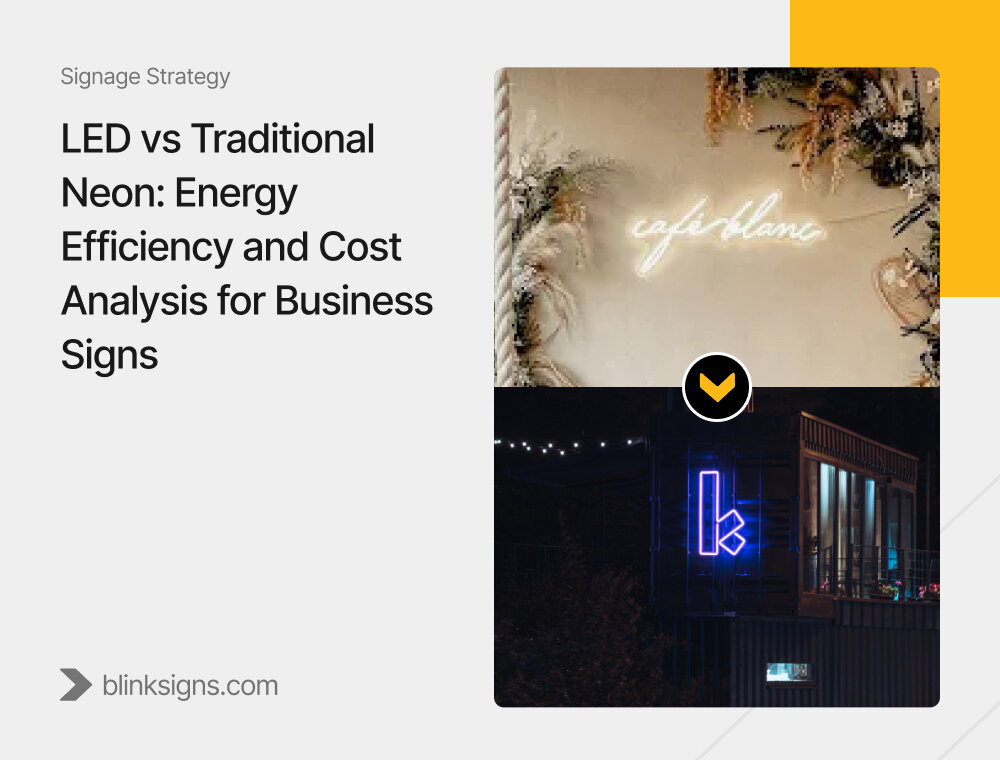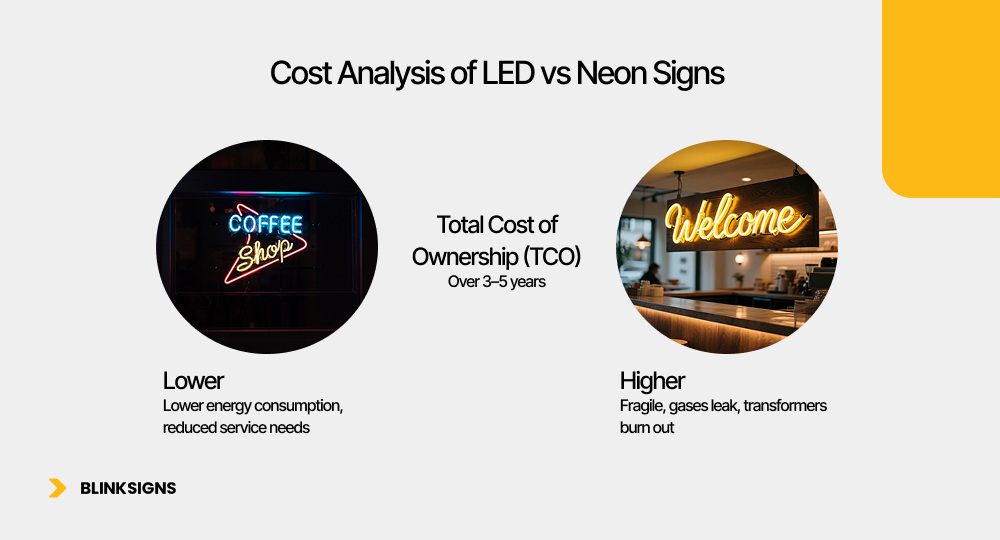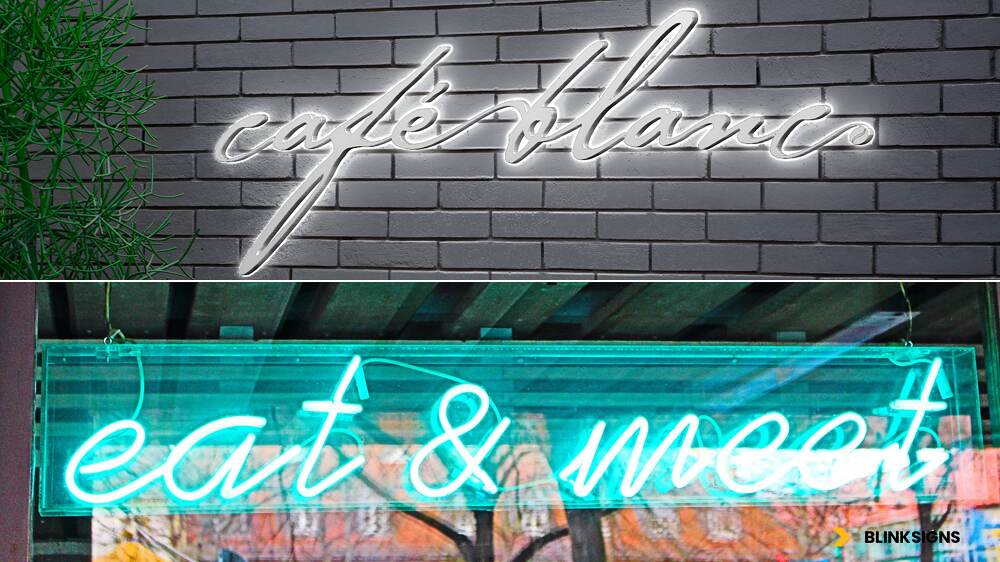
LED vs Traditional Neon: Energy Efficiency and Cost Analysis for Business Signs
Business Decisions Start with Lighting
Every storefront sign does more than just carry a name. It’s a business investment, shaping how customers see your brand and how much you spend keeping that message visible. Owners often find themselves weighing a common question: Should we choose LED or traditional neon signage?
The decision is bigger than style. It impacts energy bills, safety compliance, maintenance costs, and long-term return on investment (ROI). At BlinkSigns, we help businesses navigate this choice with data-driven insight and real-world experience—so signage works harder for visibility and the bottom line.
Why the LED vs Traditional Neon Debate Still Matters
For decades, neon signs defined nightlife, restaurants, and retail. Their distinctive glow created an atmosphere and brand recognition that many businesses still admire.
But the rise of LED signage has shifted the conversation. LEDs are more than just a modern option—they’ve become the standard for businesses seeking efficiency, flexibility, and sustainability.
- Neon remains iconic for its warm glow, often chosen for artistic or nostalgic branding.
- LED dominates practicality, offering cost savings and broader creative control.
The debate isn’t about which is universally “better”—it’s about which aligns with a business’s goals, location, and customer expectations.
Energy Efficiency: The Numbers That Matter
Lighting is one of the most significant hidden costs in signage. Here’s how LED and neon compare:
Power Consumption
- LED signs: Use 6–10 watts per foot.
- Neon signs: Use 60–100 watts per foot.
That’s nearly 10x more energy efficiency with LED.
Brightness & Visibility
- LEDs: Brighter per watt, with adjustable luminosity for indoor/outdoor use.
- Neon: Softer glow, ideal for ambiance but less effective in high-light environments.
Heat & Safety
- LEDs: Generate minimal heat, reducing fire risk.
- Neon: High-voltage transformers and glass tubes increase operational hazards.
Cost Analysis: Beyond the Upfront Expense
A sign isn’t a one-time purchase—it’s an asset with ongoing costs.

Cost Analysis of led vs neon signs
Installation
- Neon signs often require specialized handling due to fragile glass tubes.
- LEDs are lighter and faster to install, lowering setup complexity.
Maintenance
- Neon: Tubes can crack, gases leak, and transformers burn out.
- LED: Modular design allows partial replacements with less downtime.
Total Cost of Ownership (TCO)
Over 3–5 years, LED signage consistently outperforms neon in cost control. The lower energy consumption and reduced service needs create a faster ROI, especially for businesses with extended operating hours.
Durability & Lifespan: Reliability That Pays Off
- LED signs: Lifespan of 50,000+ hours, fading gradually instead of failing suddenly.
- Neon signs: Average of 10,000–15,000 hours, with higher breakage risk.
Environmental exposure matters: neon struggles in harsh weather, while LEDs withstand temperature swings, moisture, and impact with less risk.
This difference directly ties to business continuity—fewer outages mean consistent branding, no dark storefronts, and fewer service calls.
Aesthetics and Brand Identity
While performance and cost drive many decisions, the look and feel of signage still matter to business owners.

Aesthetics and Brand Identity
- Neon delivers a warm, nostalgic glow, often associated with retro diners, entertainment venues, and artistic brands. Its soft light evokes emotion and a sense of tradition.
- LEDs provide flexibility: from sharp, modern lines to RGB programmable displays, offering more customization for brands that need dynamic visuals.
The decision comes down to brand positioning. A boutique café seeking vintage appeal may lean toward neon, while a tech startup or retail chain focused on visibility and efficiency benefits from LEDs.
Compliance and Safety Considerations
Business signage must do more than look good—it must meet local codes and safety standards.
- LED Signs: UL certified, low-voltage operation, safer for employees and customers.
- Neon Signs: Require high-voltage transformers, more frequent safety checks, and careful handling during repairs.
Many cities across the U.S. are updating codes to encourage energy-efficient LED adoption, meaning businesses that switch early avoid costly retrofits later.
ROI Framework: Measuring Long-Term Value
Understanding signage ROI requires looking beyond upfront cost. At BlinkSigns, we often break it down into four measurable areas:
| ROI Factor | LED Signs | Neon Signs | Business Impact |
| Energy Savings | 70–80% lower | High usage | Reduced utility bills |
| Lifespan | 50,000+ hrs | 10,000–15,000 hrs | Longer uninterrupted branding |
| Maintenance | Minimal, modular | Frequent tube/transformer replacement | Lower service costs |
| Brand Visibility | High brightness, programmable | Unique ambiance | Improved foot traffic, more substantial presence |
Key Insight: LEDs consistently deliver higher ROI for long-term business growth, while neon’s ROI is tied to its unique brand aesthetic rather than financial efficiency.
Future-Proofing Business Signage
The signage industry is evolving rapidly. LED technology continues to advance with features like:
- Intelligent connectivity for programmable displays.
- RGB and full-color flexibility for seasonal or promotional updates.
- Sustainable materials that align with eco-conscious business practices.
While neon holds cultural and artistic value, businesses seeking scalability, compliance, and cost control increasingly adopt LEDs as the future standard.
Frequently Asked Questions
Which is cheaper to run: LED or neon signs?
LED signs are significantly cheaper, using nearly 90% less energy than neon. For businesses open late or 24/7, the savings add up quickly.
Do LED signs last longer than neon?
Yes. LEDs average 50,000+ hours, while neon typically lasts 10,000–15,000 hours and requires more frequent repairs.
Are neon signs still relevant for businesses?
Absolutely. While less energy-efficient, neon remains popular for restaurants, bars, and boutique retailers seeking an authentic retro glow.
Which is more eco-friendly: LED or neon?
LEDs are far more eco-friendly. They contain no hazardous gases like mercury, consume less electricity, and align with sustainable business practices.
How do I calculate the ROI of my signage?
ROI comes from lower operating costs, longer lifespan, reduced maintenance, and improved customer visibility. At BlinkSigns, we provide businesses with ROI projections before installation to help them make data-driven choices.
Choosing Smart for Long-Term Impact
Every business must weigh style against substance. Neon brings tradition and artistry, while LED delivers measurable financial and operational advantages.
At BlinkSigns, our role is to help you choose signage that matches both your brand identity and your business goals—whether that’s the timeless glow of neon or the modern efficiency of LED.